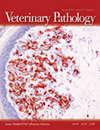Standardized bone marrow assessment, risk variables, and survival in dogs with myelodysplastic syndrome and acute myeloid leukemia
IF 2.3
2区 农林科学
Q2 PATHOLOGY
引用次数: 0
Abstract
Myelodysplastic syndrome (MDS) and acute myeloid leukemia (AML) are heterogeneous neoplasms of hematopoietic stem cells that are challenging to diagnose, differentiate, and prognosticate. Cytogenetic and mutational analyses are useful in humans but unavailable for dogs, where diagnosis and classification still rely largely on hematologic and morphologic assessment. The objectives of this study were to apply a classification scheme to myeloid neoplasms and to assess outcome in relation to predictor variables. Keyword search of a laboratory database, application of sequential exclusion criteria, and consensus from 3 reviewers yielded 70 cases of myeloid neoplasia with hematology results, and cytologic (11), histologic (14), or both (45) types of marrow specimens. Based on blast percentage and morphology, 42 cases were classified as MDS and 28 as AML. Dogs with MDS had significantly lower body weights, hemoglobin concentrations and blood blasts, and higher red blood cell size variability and platelet numbers than dogs with AML. Estimates of median survival using Kaplan-Meier curves for dogs with MDS and AML were 384 and 6 days, respectively ( P < .001). The instantaneous risk of death for dogs with MDS was approximately 5× lower than that of dogs with AML. Significant predictor variables of survival were body weight, white blood cell count, platelet count, and percent blood blasts ( P < .05). Hazard ratios (HRs) derived from best-fitting Cox regression models were 1.043, 0.998, and 1.061 for increased neutrophils, decreased platelets, and increased blood blasts, respectively. Findings from this study suggest that hematologic and morphologic variables are useful to predict outcomes in myeloid neoplasia.骨髓增生异常综合征和急性髓性白血病患犬的标准化骨髓评估、风险变量和存活率
骨髓增生异常综合症(MDS)和急性髓性白血病(AML)是造血干细胞的异质性肿瘤,在诊断、分化和预后方面具有挑战性。细胞遗传学和突变分析对人类很有用,但对狗却不适用,狗的诊断和分类仍主要依靠血液学和形态学评估。本研究的目的是将分类方案应用于骨髓性肿瘤,并评估与预测变量相关的预后。通过对实验室数据库进行关键词搜索、应用顺序性排除标准以及 3 位审稿人的共识,得出了 70 例具有血液学结果的骨髓肿瘤病例,以及细胞学(11 例)、组织学(14 例)或两种类型(45 例)的骨髓标本。根据胚泡百分比和形态,42 例被归类为 MDS,28 例被归类为 AML。与急性髓细胞性白血病患犬相比,MDS 患犬的体重、血红蛋白浓度和血细胞数明显较低,而红细胞大小变异性和血小板数则较高。根据 Kaplan-Meier 曲线估算,MDS 和 AML 患犬的中位生存期分别为 384 天和 6 天(P < .001)。患 MDS 的狗的瞬时死亡风险比患 AML 的狗低约 5 倍。体重、白细胞计数、血小板计数和血细胞百分比是生存率的重要预测变量 ( P < .05)。最佳拟合 Cox 回归模型得出的中性粒细胞增多、血小板减少和血细胞增多的危险比(HRs)分别为 1.043、0.998 和 1.061。这项研究的结果表明,血液学和形态学变量有助于预测骨髓肿瘤的预后。
本文章由计算机程序翻译,如有差异,请以英文原文为准。
求助全文
约1分钟内获得全文
求助全文
来源期刊

Veterinary Pathology
农林科学-病理学
CiteScore
4.70
自引率
8.30%
发文量
99
审稿时长
2 months
期刊介绍:
Veterinary Pathology (VET) is the premier international publication of basic and applied research involving domestic, laboratory, wildlife, marine and zoo animals, and poultry. Bridging the divide between natural and experimental diseases, the journal details the diagnostic investigations of diseases of animals; reports experimental studies on mechanisms of specific processes; provides unique insights into animal models of human disease; and presents studies on environmental and pharmaceutical hazards.
 求助内容:
求助内容: 应助结果提醒方式:
应助结果提醒方式:


